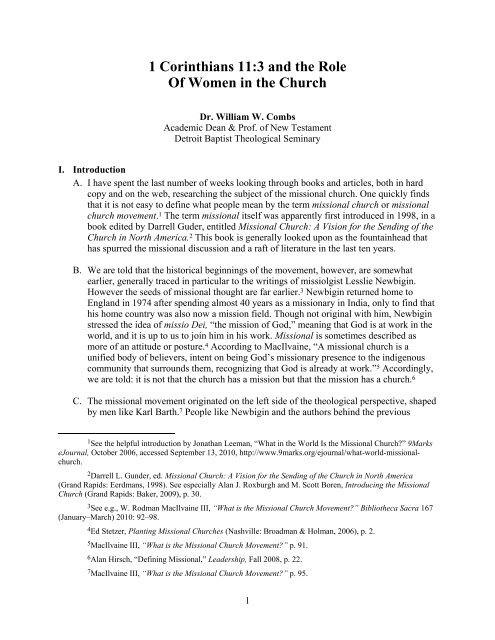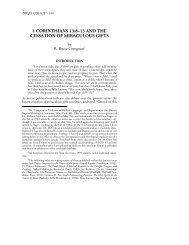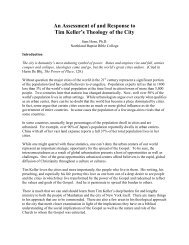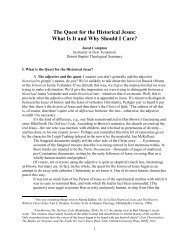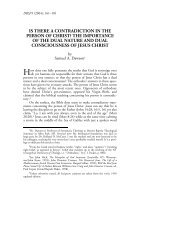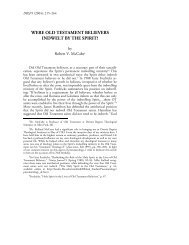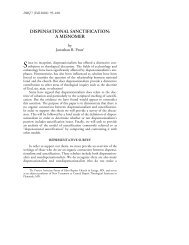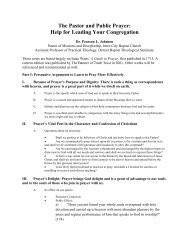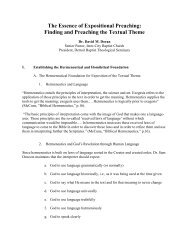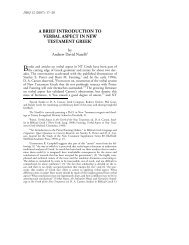Combs, Role of Women in the Church - Detroit Baptist Theological ...
Combs, Role of Women in the Church - Detroit Baptist Theological ...
Combs, Role of Women in the Church - Detroit Baptist Theological ...
Create successful ePaper yourself
Turn your PDF publications into a flip-book with our unique Google optimized e-Paper software.
1 Cor<strong>in</strong>thians 11:3 and <strong>the</strong> <strong>Role</strong>Of <strong>Women</strong> <strong>in</strong> <strong>the</strong> <strong>Church</strong>Dr. William W. <strong>Combs</strong>Academic Dean & Pr<strong>of</strong>. <strong>of</strong> New Testament<strong>Detroit</strong> <strong>Baptist</strong> <strong>Theological</strong> Sem<strong>in</strong>aryI. IntroductionA. I have spent <strong>the</strong> last number <strong>of</strong> weeks look<strong>in</strong>g through books and articles, both <strong>in</strong> hardcopy and on <strong>the</strong> web, research<strong>in</strong>g <strong>the</strong> subject <strong>of</strong> <strong>the</strong> missional church. One quickly f<strong>in</strong>dsthat it is not easy to def<strong>in</strong>e what people mean by <strong>the</strong> term missional church or missionalchurch movement. 1 The term missional itself was apparently first <strong>in</strong>troduced <strong>in</strong> 1998, <strong>in</strong> abook edited by Darrell Guder, entitled Missional <strong>Church</strong>: A Vision for <strong>the</strong> Send<strong>in</strong>g <strong>of</strong> <strong>the</strong><strong>Church</strong> <strong>in</strong> North America. 2 This book is generally looked upon as <strong>the</strong> founta<strong>in</strong>head thathas spurred <strong>the</strong> missional discussion and a raft <strong>of</strong> literature <strong>in</strong> <strong>the</strong> last ten years.B. We are told that <strong>the</strong> historical beg<strong>in</strong>n<strong>in</strong>gs <strong>of</strong> <strong>the</strong> movement, however, are somewhatearlier, generally traced <strong>in</strong> particular to <strong>the</strong> writ<strong>in</strong>gs <strong>of</strong> missiolgist Lesslie Newbig<strong>in</strong>.However <strong>the</strong> seeds <strong>of</strong> missional thought are far earlier. 3 Newbig<strong>in</strong> returned home toEngland <strong>in</strong> 1974 after spend<strong>in</strong>g almost 40 years as a missionary <strong>in</strong> India, only to f<strong>in</strong>d thathis home country was also now a mission field. Though not orig<strong>in</strong>al with him, Newbig<strong>in</strong>stressed <strong>the</strong> idea <strong>of</strong> missio Dei, “<strong>the</strong> mission <strong>of</strong> God,” mean<strong>in</strong>g that God is at work <strong>in</strong> <strong>the</strong>world, and it is up to us to jo<strong>in</strong> him <strong>in</strong> his work. Missional is sometimes described asmore <strong>of</strong> an attitude or posture. 4 Accord<strong>in</strong>g to MacIlva<strong>in</strong>e, “A missional church is aunified body <strong>of</strong> believers, <strong>in</strong>tent on be<strong>in</strong>g God’s missionary presence to <strong>the</strong> <strong>in</strong>digenouscommunity that surrounds <strong>the</strong>m, recogniz<strong>in</strong>g that God is already at work.” 5 Accord<strong>in</strong>gly,we are told: it is not that <strong>the</strong> church has a mission but that <strong>the</strong> mission has a church. 6C. The missional movement orig<strong>in</strong>ated on <strong>the</strong> left side <strong>of</strong> <strong>the</strong> <strong>the</strong>ological perspective, shapedby men like Karl Barth. 7 People like Newbig<strong>in</strong> and <strong>the</strong> authors beh<strong>in</strong>d <strong>the</strong> previous1 See <strong>the</strong> helpful <strong>in</strong>troduction by Jonathan Leeman, “What <strong>in</strong> <strong>the</strong> World Is <strong>the</strong> Missional <strong>Church</strong>?” 9MarkseJournal, October 2006, accessed September 13, 2010, http://www.9marks.org/ejournal/what-world-missionalchurch.2 Darrell L. Gunder, ed. Missional <strong>Church</strong>: A Vision for <strong>the</strong> Send<strong>in</strong>g <strong>of</strong> <strong>the</strong> <strong>Church</strong> <strong>in</strong> North America(Grand Rapids: Eerdmans, 1998). See especially Alan J. Roxburgh and M. Scott Boren, Introduc<strong>in</strong>g <strong>the</strong> Missional<strong>Church</strong> (Grand Rapids: Baker, 2009), p. 30.3 See e.g., W. Rodman MacIlva<strong>in</strong>e III, “What is <strong>the</strong> Missional <strong>Church</strong> Movement?” Biblio<strong>the</strong>ca Sacra 167(January–March) 2010: 92–98.4 Ed Stetzer, Plant<strong>in</strong>g Missional <strong>Church</strong>es (Nashville: Broadman & Holman, 2006), p. 2.5 MacIlva<strong>in</strong>e III, “What is <strong>the</strong> Missional <strong>Church</strong> Movement?” p. 91.6 Alan Hirsch, “Def<strong>in</strong><strong>in</strong>g Missional,” Leadership, Fall 2008, p. 22.7 MacIlva<strong>in</strong>e III, “What is <strong>the</strong> Missional <strong>Church</strong> Movement?” p. 95.1
2mentioned Missional <strong>Church</strong>: A Vision for <strong>the</strong> Send<strong>in</strong>g <strong>of</strong> <strong>the</strong> <strong>Church</strong> <strong>in</strong> North Americaare not what one would call evangelical, yet missional th<strong>in</strong>k<strong>in</strong>g has quickly moved <strong>in</strong>to<strong>the</strong> evangelical ma<strong>in</strong>stream. The missional church movement is closely aligned with <strong>the</strong>emerg<strong>in</strong>g church movement. 8 Dan Kimball, a recognized authority on <strong>the</strong> emerg<strong>in</strong>gchurch has said: “To my best understand<strong>in</strong>g <strong>the</strong> emerg<strong>in</strong>g church and <strong>the</strong> missionalchurch are very much <strong>the</strong> same.” 9 Not everyone agrees on that po<strong>in</strong>t, 10 yet it is true thatpeople like Mark Driscoll and Brian McLaren clearly move <strong>in</strong> both camps. In actuality,<strong>the</strong> missional and emerg<strong>in</strong>g church movements have different orig<strong>in</strong>s, with differentfound<strong>in</strong>g leaders, though <strong>the</strong>y share many <strong>of</strong> <strong>the</strong> same concerns. 11 Today it woulddifficult to f<strong>in</strong>d an emerg<strong>in</strong>g church leader who does not use missional language.D. The missional movement today takes it leaders from across <strong>the</strong> <strong>the</strong>ological spectrum,from <strong>the</strong> more conservative evangelicals like Ed Stetzer 12 and Tim Keller 13 all <strong>the</strong> way toits liberal pioneers like Darrell Guder. 14 In general, groups associated with <strong>the</strong> missionalchurch movement tend to be to <strong>the</strong> left <strong>of</strong> <strong>the</strong> <strong>the</strong>ological spectrum. For <strong>in</strong>stance, abouttwenty years ago when so-called moderates and conservatives were vy<strong>in</strong>g for control <strong>of</strong><strong>the</strong> Sou<strong>the</strong>rn <strong>Baptist</strong> Convention, and it became clear that <strong>the</strong> conservatives were go<strong>in</strong>gto w<strong>in</strong>, a large number <strong>of</strong> <strong>the</strong>se “moderates” left to form <strong>the</strong> Cooperative <strong>Baptist</strong>Fellowship. Accord<strong>in</strong>g to <strong>the</strong>ir website, <strong>the</strong> Fellowship is “committed to <strong>the</strong> perspectiveand posture <strong>of</strong> <strong>the</strong> Missional <strong>Church</strong>.” 15 One <strong>of</strong> <strong>the</strong> found<strong>in</strong>g pr<strong>in</strong>ciples <strong>of</strong> <strong>the</strong> Fellowshipand a major reason for <strong>the</strong>ir split with <strong>the</strong> SBC is <strong>the</strong> issue <strong>of</strong> women <strong>in</strong> <strong>the</strong> m<strong>in</strong>istry <strong>of</strong><strong>the</strong> church.E. The found<strong>in</strong>g document <strong>of</strong> Cooperative <strong>Baptist</strong> Fellowship has this statement aboutwomen:The New Testament gives two signals about <strong>the</strong> role <strong>of</strong> women. A literal <strong>in</strong>terpretation <strong>of</strong> Paul canbuild a case for mak<strong>in</strong>g women submissive to men <strong>in</strong> <strong>the</strong> <strong>Church</strong>. But ano<strong>the</strong>r body <strong>of</strong> scripture po<strong>in</strong>tstoward ano<strong>the</strong>r place for women. In Gal 3:27-28 Paul wrote, “As many <strong>of</strong> you as are baptized <strong>in</strong>toChrist have clo<strong>the</strong>d yourselves with Christ. There is no longer Jew or Greek, <strong>the</strong>re is no longer slave8 For simplicity sake I am here equat<strong>in</strong>g emerg<strong>in</strong>g with emergent as per D. A. Carson (Becom<strong>in</strong>gConversant with <strong>the</strong> Emerg<strong>in</strong>g <strong>Church</strong> [Grand Rapids: Zondervan, 2005], p. 12). The terms are, however,commonly differentiated. See Just<strong>in</strong> Taylor, “An Emerg<strong>in</strong>g <strong>Church</strong> Primer,” 9Marks eJournal, September 2006,accessed September 13, 2010, http://www.9marks.org/ejournal/emerg<strong>in</strong>g-church-primer.9 Url Scaramanga, “Emerg<strong>in</strong>g + Missional = Emergissional.” September 6, 2007, accessed September 13,2010, http://www.out<strong>of</strong>ur.com/archives/2007/09/emerg<strong>in</strong>g_missio.html.10 Hirsch, for example, says “missional is not synonymous with emerg<strong>in</strong>g” (“Def<strong>in</strong><strong>in</strong>g Missional,” p. 22).11 Jim Thomas, “The Missional <strong>Church</strong>,” accessed September 13, 2010, http://www.urbana.org/articles/<strong>the</strong>missional-church12 Stetzer is president <strong>of</strong> LifeWay Research and LifeWay’s missiologist <strong>in</strong> residence. LifeWay is ownedand operated by <strong>the</strong> Sou<strong>the</strong>rn <strong>Baptist</strong> Convention.13 “The Missional <strong>Church</strong>,” accessed September 13, 2010, http://www.redeemer2.com/resources/papers/missional.pdf. Keller is <strong>the</strong> well-known pastor <strong>of</strong> Redeemer Presbyterian <strong>Church</strong> <strong>in</strong> New York City. See this helpfulvideo from Desir<strong>in</strong>g God, http://www.youtube.com/watch?v=zFFlSb-Zsc8.14 Guder is currently <strong>the</strong> Henry W<strong>in</strong>ters Luce Pr<strong>of</strong>essor <strong>of</strong> Missional and Ecumenical Theology atPr<strong>in</strong>ceton <strong>Theological</strong> Sem<strong>in</strong>ary.15 Accessed September 13, 2010, http://www.<strong>the</strong>fellowship.<strong>in</strong>fo/missional.
3or free, <strong>the</strong>re is no longer male and female; for all <strong>of</strong> you are one <strong>in</strong> Christ Jesus (NRSV).”We take Galatians as a clue to <strong>the</strong> way <strong>the</strong> <strong>Church</strong> should be ordered. We <strong>in</strong>terpret <strong>the</strong> referenceto women <strong>the</strong> same way we <strong>in</strong>terpret <strong>the</strong> reference to slaves. If we have submissive roles for women,we must also have a place for <strong>the</strong> slaves <strong>in</strong> <strong>the</strong> <strong>Church</strong>.In Galatians Paul follows <strong>the</strong> spirit <strong>of</strong> Jesus who courageously challenged <strong>the</strong> conventionalwisdom <strong>of</strong> his day. It was a wisdom with rigid boundaries between men and women <strong>in</strong> religion and <strong>in</strong>public life. Jesus deliberately broke those barriers. He called women to follow him; he treated womenas equally capable <strong>of</strong> deal<strong>in</strong>g with sacred issues. Our model for <strong>the</strong> role <strong>of</strong> women <strong>in</strong> matters <strong>of</strong> faith is<strong>the</strong> Lord Jesus. 16The Fellowship <strong>in</strong>sists that women may be pastors or hold any o<strong>the</strong>r leadership role <strong>in</strong><strong>the</strong>ir denom<strong>in</strong>ation.F. What I am argu<strong>in</strong>g, though far from universally true, is that <strong>the</strong>re is a general tendencyamong self-identified missional and emerg<strong>in</strong>g churches to allow a greater role for women<strong>in</strong> church m<strong>in</strong>istry and leadership positions, particularly <strong>the</strong> <strong>of</strong>fice <strong>of</strong> pastor/elder. As <strong>in</strong><strong>the</strong> case <strong>of</strong> <strong>the</strong> Cooperative <strong>Baptist</strong> Fellowship, <strong>the</strong>re is <strong>of</strong>ten a denial <strong>of</strong> <strong>the</strong> traditional,complementarian role <strong>of</strong> women <strong>in</strong> <strong>the</strong> church, and a re<strong>in</strong>terpretation <strong>of</strong> key biblical textsto support <strong>the</strong> new, egalitarian viewpo<strong>in</strong>t. The missional church movement is morenormally aligned with egalitarianism.II. Fram<strong>in</strong>g <strong>the</strong> IssueA. These terms, complementarian and egalitarian, are <strong>the</strong> commonly used labels for <strong>the</strong> twomajor viewpo<strong>in</strong>ts with<strong>in</strong> broad evangelicalism concern<strong>in</strong>g <strong>the</strong> role <strong>of</strong> women <strong>in</strong> <strong>the</strong>church. Complementarianism affirmsthat men and women are equal <strong>in</strong> <strong>the</strong> image <strong>of</strong> God, but ma<strong>in</strong>ta<strong>in</strong> complementary differences <strong>in</strong> roleand function. In <strong>the</strong> home, men lov<strong>in</strong>gly are to lead <strong>the</strong>ir wives and family as women <strong>in</strong>telligently areto submit to <strong>the</strong> leadership <strong>of</strong> <strong>the</strong>ir husbands. In <strong>the</strong> church, while men and women share equally <strong>in</strong> <strong>the</strong>bless<strong>in</strong>gs <strong>of</strong> salvation, some govern<strong>in</strong>g and teach<strong>in</strong>g roles are restricted to men. 17The complementarian position is represented by <strong>the</strong> Council on Biblical Manhood andWomanhood (CBMW). The CBMW was <strong>of</strong>ficially formed <strong>in</strong> December 1987 at <strong>the</strong>annual meet<strong>in</strong>g <strong>of</strong> <strong>the</strong> Evangelical <strong>Theological</strong> Society (ETS) <strong>in</strong> Danvers, MA. 18 At thatmeet<strong>in</strong>g <strong>the</strong> Council drew up <strong>the</strong>ir found<strong>in</strong>g document, <strong>the</strong> Danvers Statement, 19 thoughit was not f<strong>in</strong>alized and made public until November 1988 at <strong>the</strong> next ETS meet<strong>in</strong>g. Itwas later published as an advertisement <strong>in</strong> Christianity Today on January 13, 1989.Accord<strong>in</strong>g to Wayne Grudem, <strong>the</strong> lead<strong>in</strong>g light beh<strong>in</strong>d <strong>the</strong> CBMW, it was at this meet<strong>in</strong>gthat <strong>the</strong> term complementarian was co<strong>in</strong>ed. 20 The name was chosen because “it suggestsboth equality and beneficial differences between men and women.” 2116 “Address to <strong>the</strong> Public: The found<strong>in</strong>g document <strong>of</strong> Cooperative <strong>Baptist</strong> Fellowship,” accessed September13, 2010, http://www.<strong>the</strong>fellowship.<strong>in</strong>fo/Files/About-Us/Address.aspx.17 The Council on Biblical Manhood & Womanhood, “About Us,” accessed September 27, 2010,http://www.cbmw.org/About-Us.18 Wayne Grudem, “Personal Reflections on <strong>the</strong> History <strong>of</strong> CBMW and <strong>the</strong> State <strong>of</strong> <strong>the</strong> Gender Debate,”Journal for Biblical Manhood & Womanhood 14 (Spr<strong>in</strong>g 2009): 14.19 http://www.cbmw.org/Danvers.20 Grudem, “Personal Reflections on <strong>the</strong> History <strong>of</strong> CBMW,” p. 14.21 John Piper and Wayne Grudem, Recover<strong>in</strong>g Biblical Manhood & Womanhood (Wheaton, IL: Crossway,
4B. Egalitarianism is also commonly known as evangelical fem<strong>in</strong>ism. It is an outgrowth <strong>of</strong><strong>the</strong> secular fem<strong>in</strong>ist movement that reemerged <strong>in</strong> North America <strong>in</strong> <strong>the</strong> early 1960s. 22 In<strong>the</strong> early 1970s conservative evangelicals began to <strong>in</strong>corporate fem<strong>in</strong>ist ideas <strong>in</strong>to <strong>the</strong>ir<strong>the</strong>ology. 23 In 1974 biblical fem<strong>in</strong>ists founded <strong>the</strong> Evangelical <strong>Women</strong>’s Caucus (EWC).Though orig<strong>in</strong>ally conservative, it eventually took a positive stance towardhomosexuality. This led some members <strong>of</strong> <strong>the</strong> EWC to form a new organization <strong>in</strong> 1987called Christians for Biblical Equality (CBE), 24 which today represents <strong>the</strong> moreconservative egalitarian position. In July 1989 <strong>the</strong>y produced <strong>the</strong>ir found<strong>in</strong>g statement,“Men, <strong>Women</strong>, and Biblical Equality,” 25 which was later published as an advertisement<strong>in</strong> Christianity Today on April 9, 1990. CBE believes that “all believers—without regardto gender, ethnicity or class—must exercise <strong>the</strong>ir God-given gifts with equal authorityand equal responsibility <strong>in</strong> church, home and world.” 26 So CBE (egalitarianism) differsfrom CBMW (complementarianism) <strong>in</strong> that <strong>the</strong> former sees no leadership role for <strong>the</strong>husband <strong>in</strong> marriage and also <strong>in</strong>sists that <strong>the</strong>re is no leadership role <strong>in</strong> <strong>the</strong> church that isreserved for men.C. Egalitarians come to <strong>the</strong>ir position by <strong>in</strong>terpret<strong>in</strong>g certa<strong>in</strong> key verses <strong>in</strong> Scripture quitedifferently than <strong>the</strong>y have traditionally been understood. One <strong>of</strong> <strong>the</strong> most important <strong>of</strong><strong>the</strong>se texts is 1 Cor<strong>in</strong>thians 11:3. There Paul says, “But I want you to understand thatChrist is <strong>the</strong> head <strong>of</strong> every man, and <strong>the</strong> man is <strong>the</strong> head <strong>of</strong> a woman, and God is <strong>the</strong> head<strong>of</strong> Christ.” 27 Traditionally, <strong>the</strong> word “head,” <strong>the</strong> Greek kephalē (κεφαλή), has beenunderstood <strong>in</strong> <strong>the</strong> figurative sense <strong>of</strong> “authority over.” Thus, Paul is say<strong>in</strong>g that Christ is<strong>the</strong> authority over every man, and <strong>the</strong> man is <strong>the</strong> authority over a woman, and God is <strong>the</strong>authority over Christ. Equally important for <strong>the</strong> issue <strong>of</strong> <strong>the</strong> role <strong>of</strong> women <strong>in</strong> <strong>the</strong> churchand <strong>the</strong> home is <strong>the</strong> use <strong>of</strong> “head,” kephalē, <strong>in</strong> Ephesians 5:23, “For <strong>the</strong> husband is <strong>the</strong>head <strong>of</strong> <strong>the</strong> wife, as Christ also is <strong>the</strong> head <strong>of</strong> <strong>the</strong> church, He Himself be<strong>in</strong>g <strong>the</strong> Savior <strong>of</strong><strong>the</strong> body.” Aga<strong>in</strong>, Paul would seem to be affirm<strong>in</strong>g that <strong>the</strong> husband is <strong>the</strong> authority overhis wife just as Christ is <strong>the</strong> authority over his church.D. It would appear that <strong>the</strong>se two verses argue for a general authority <strong>of</strong> men over womenand a unique authority for <strong>the</strong> husband <strong>in</strong> marriage that is parallel to Christ’s authorityover his church. The force <strong>of</strong> <strong>the</strong>se verses is well understood by egalitarians. For1991, p. xiv. Grudem has recently compla<strong>in</strong>ed that egalitarians are object<strong>in</strong>g to complementarians’ use <strong>of</strong> <strong>the</strong> termand are attempt<strong>in</strong>g to co-opt it for <strong>the</strong>ir own use (Wayne Grudem, Counter<strong>in</strong>g <strong>the</strong> Claims <strong>of</strong> Evangelical Fem<strong>in</strong>ism[Colorado Spr<strong>in</strong>gs, CO: Multomah, 2006, p. 13). See Ronald W. Pierce and Rebecca M. Groothuis, Discover<strong>in</strong>gBiblical Equality: Complementarity Without Hierarchy (Downers Grove, IL: InterVarsity, 2004), p. 15.22 Mary A. Kassian, The Fem<strong>in</strong>ist Gospel (Wheaton, IL: Crossway, 1992), p. 15.23 Ibid., p. 206.24 “Christian Fem<strong>in</strong>ists form New Organization,” Christianity Today, 16 October 1987, p. 44.25 www.cbe<strong>in</strong>ternational.org/?q=content/men-women-and-biblical-equality.26 CBE Mission Statement, accessed September 29, 2010, http://www.cbe<strong>in</strong>ternational.org/?q=content/ourmission-and-history.Bible.27 Unless o<strong>the</strong>rwise noted, all scriptural references are to <strong>the</strong> 1995 edition <strong>of</strong> <strong>the</strong> New American Standard
5example, <strong>the</strong> Mickelsens (egalitarians) say: “The belief <strong>of</strong> some Christians that <strong>the</strong> Bibleteaches a hierarchy, with men <strong>in</strong> a role <strong>of</strong> authority over women (basically over allwomen and very specifically over <strong>the</strong>ir wives) is based largely on two references by Paulto males (or husbands) as <strong>the</strong> ‘head’ <strong>of</strong> women (or wives), 1 Cor<strong>in</strong>thians 11:3 andEphesians 5:23.” 28 Egalitarians have developed a number <strong>of</strong> ways to blunt <strong>the</strong> force <strong>of</strong><strong>the</strong>se two verses, but primarily <strong>the</strong>y have argued that kephalē does not mean “authorityover” but some sense less problematic for <strong>the</strong>ir position, such as “source.”III. The Mean<strong>in</strong>g <strong>of</strong> KephalēA. The understad<strong>in</strong>g <strong>of</strong> “source” for kephalē (κεφαλή) <strong>in</strong> 1 Cor<strong>in</strong>thians 11:3 is a new andnovel idea. No English translation has every adopted this gloss. The translation “head”is found <strong>in</strong> <strong>the</strong> KJV, RV, ASV, RSV, NEB, JB, NAB, NASB, NIV, NKJV, REB, NRSV, CEB, CEV,TNIV, NET BIBLE, HCSB, and ESV. 29 As might be expected, until recently no commentaryever suggested “source” as a possible mean<strong>in</strong>g. Even Gordon Fee, who argues for“source” <strong>in</strong> his respected commentary, admits that “head” “is <strong>of</strong>ten understood to behierarchical, sett<strong>in</strong>g up structures <strong>of</strong> authority” and that such was <strong>the</strong> universalunderstand<strong>in</strong>g <strong>of</strong> <strong>the</strong> commentaries until Barrett (1968) and Conzelmann (1975). 30 Thestandard lexicon <strong>of</strong> New Testament Greek (BDAG), which is usually consideredauthoritative on issues <strong>of</strong> mean<strong>in</strong>g, lists only two senses for kephalē, one literal, “<strong>the</strong>part <strong>of</strong> <strong>the</strong> body that conta<strong>in</strong>s <strong>the</strong> bra<strong>in</strong>, head,” and one figurative, “a be<strong>in</strong>g <strong>of</strong> highstatus, head.” This figurative mean<strong>in</strong>g is subdivided <strong>in</strong>to two parts, <strong>the</strong> first <strong>of</strong> which is“<strong>in</strong> <strong>the</strong> case <strong>of</strong> liv<strong>in</strong>g be<strong>in</strong>gs, to denote superior rank.” It is <strong>in</strong>to this category that <strong>the</strong>lexicon places 1 Cor<strong>in</strong>thians 11:3 and Ephesians 5:23. 31B. The first scholar to suggest <strong>the</strong> translation “source” for kephalē <strong>in</strong> 1 Cor<strong>in</strong>thians 11:3was probably Stephen Bedale <strong>in</strong> a short four-page article <strong>in</strong> 1954. 32 He argued that <strong>in</strong>normal Greek usage kephalē does not normally mean “head” <strong>in</strong> <strong>the</strong> sense <strong>of</strong> “ruler.”Thus it has no sense <strong>of</strong> “authority over.” Second, Bedale <strong>in</strong>sists that <strong>the</strong> ancients had noconcept <strong>of</strong> <strong>the</strong> head controll<strong>in</strong>g <strong>the</strong> physical body so that <strong>the</strong> idea <strong>of</strong> <strong>the</strong> Christ <strong>the</strong> head<strong>of</strong> <strong>the</strong> church rul<strong>in</strong>g his body is impossible <strong>in</strong> a text like Ephesians 4:15 (“but speak<strong>in</strong>g<strong>the</strong> truth <strong>in</strong> love, we are to grow up <strong>in</strong> all aspects <strong>in</strong>to Him who is <strong>the</strong> head, evenChrist”). Thus <strong>in</strong> Ephesians 4:15 (and Col 2:19) kephalē probably means “source.” It is28 Berkeley & Alvera Mickelsen, “What Does KEPHALĒ Mean <strong>in</strong> <strong>the</strong> New Testament?” <strong>in</strong> <strong>Women</strong>Authority and <strong>the</strong> Bible, ed. Alvera Mickelsen (Downers Grove, IL: InterVarsity, 1986) p. 97.29 The NLT, which is a more periphrastic translation, does not use “head” but gives an even more explicittranslation: “a woman is responsible to her husband.”30 Gordon D. Fee, The First Epistle to <strong>the</strong> Cor<strong>in</strong>thians, NICNT (Grand Rapids: Eerdmans, 1987), p. 502.However, Fee admits that even Barrett and Conzelmann “opt for some form <strong>of</strong> ‘subord<strong>in</strong>ation’ as <strong>in</strong>herent <strong>in</strong> <strong>the</strong>metaphor” (ibid.).31 Walter Bauer, Frederick W. Danker, William F. Arndt, and F. Wilbur G<strong>in</strong>grich, A Greek-EnglishLexicon <strong>of</strong> <strong>the</strong> New Testament and O<strong>the</strong>r Early Christian Literature, 3rd ed, rev and ed, Frederick W. Danker(Chicago: University <strong>of</strong> Chicago Press, 2000), p. 542.32 “The Mean<strong>in</strong>g <strong>of</strong> Κεφαλή <strong>in</strong> <strong>the</strong> Paul<strong>in</strong>e Epistles,” Journal <strong>of</strong> Biblical Literature 5 (1954): 211–15. For ahelpful chronological survey <strong>of</strong> <strong>the</strong> debate over <strong>the</strong> mean<strong>in</strong>g <strong>of</strong> kephalē, albeit from a egalitarian perspective, seeAlan F. Johnson, “A Review <strong>of</strong> <strong>the</strong> Scholarly Debate on <strong>the</strong> Mean<strong>in</strong>g <strong>of</strong> ‘Head’ (κεφαλη) <strong>in</strong> Paul’s Writ<strong>in</strong>gs,”Ashland <strong>Theological</strong> Journal 41 (2009): 35–57.
6p. 103.<strong>in</strong>terest<strong>in</strong>g that this is <strong>the</strong> one and only use <strong>of</strong> <strong>the</strong> word source <strong>in</strong> <strong>the</strong> entire article eventhough this article is commonly appealed to as prov<strong>in</strong>g kephalē means “source.” F<strong>in</strong>ally,Bedale argues that Paul’s understand<strong>in</strong>g <strong>of</strong> <strong>the</strong> metaphorical mean<strong>in</strong>g <strong>of</strong> kephalē comesfrom its use <strong>in</strong> <strong>the</strong> Septuag<strong>in</strong>t to translate <strong>the</strong> Hebrew rō’š. S<strong>in</strong>ce both kephalē andarchē (ἀρχή) are used to translate rō’š <strong>in</strong> <strong>the</strong> Septuag<strong>in</strong>t, Bedale concludes that kephalēmay approximate <strong>the</strong> mean<strong>in</strong>g <strong>of</strong> archē <strong>in</strong> <strong>the</strong> New Testament. This suggests that as ametaphor kephalē may have a lesser sense <strong>of</strong> “beg<strong>in</strong>n<strong>in</strong>g” ra<strong>the</strong>r than “authority over.”Thus <strong>in</strong> a text like 1 Cor<strong>in</strong>thians 11:3, <strong>the</strong> idea is that <strong>the</strong> woman derives her be<strong>in</strong>g from<strong>the</strong> man; he is her “beg<strong>in</strong>n<strong>in</strong>g,” or “source.” However, Bedale still <strong>in</strong>sists <strong>in</strong> <strong>the</strong> case <strong>of</strong>our specific text, 1 Cor<strong>in</strong>thians 11:3, “<strong>the</strong> word κεφαλή (and ἀρχή also for that matter)unquestionably carries with it <strong>the</strong> idea <strong>of</strong> ‘authority.’” 33C. Bedale’s article would not appear to have exactly overthrown <strong>the</strong> traditional mean<strong>in</strong>g <strong>of</strong>kephalē as express<strong>in</strong>g “authority over,” but it quickly became <strong>the</strong> authority to whichwhose who wished to understand kephalē as “source” <strong>in</strong> 1 Cor<strong>in</strong>thians 11:3 commonlyappealed. For example, F. F. Bruce says: “By head <strong>in</strong> this context we are probably tounderstand not, as has frequently been suggested, ‘chief’ or ‘ruler’ but ra<strong>the</strong>r ‘source’ or‘orig<strong>in</strong>’—a sense well attested for Gk kephalē.” 34 Bruce sights Bedale as his only pro<strong>of</strong>that kephalē means “source.” Literature by egalitarians picked up on Bedale’ssuggestion and universally began to po<strong>in</strong>t to “source” as <strong>the</strong> true mean<strong>in</strong>g <strong>of</strong> kephalē <strong>in</strong>1 Cor<strong>in</strong>thians 11:3. For example, Berkeley and Alvera Mickelsen published two<strong>in</strong>fluential articles <strong>in</strong> Christianity Today <strong>in</strong> which <strong>the</strong>y castigate English Bibletranslations for <strong>the</strong>ir render<strong>in</strong>g <strong>of</strong> kephalē with “head” and argue that “source” is <strong>the</strong>correct mean<strong>in</strong>g. 35D. When Wayne Grudem, who at <strong>the</strong> time was a pr<strong>of</strong>essor at Be<strong>the</strong>l College <strong>in</strong> St. Paul,MN, read <strong>the</strong> articles by <strong>the</strong> Mickelsens and began to study <strong>the</strong> issue, he was conv<strong>in</strong>cedthat <strong>the</strong> traditional understand<strong>in</strong>g <strong>of</strong> texts like 1 Cor<strong>in</strong>thians 11:3 and Ephesians 5:23was correct and that “source” was an <strong>in</strong>valid translation <strong>of</strong> kephalē <strong>in</strong> <strong>the</strong>se verses. In1985 he published a scholarly rebuttal entitled “Does Kephalē Mean ‘Source’ or‘Authority Over’? An Exam<strong>in</strong>ation <strong>of</strong> 2,336 Examples.” 36 Grudem’s article led to an<strong>in</strong>vitation for him to speak at a plenary session <strong>of</strong> <strong>the</strong> 1986 meet<strong>in</strong>g <strong>of</strong> <strong>the</strong> Evangelical<strong>Theological</strong> Society, whose <strong>the</strong>me was “Manhood and Womanhood <strong>in</strong> Biblical and<strong>Theological</strong> Perspectives.” The o<strong>the</strong>r five plenary speakers were egalitarians (GilbertBilezekian, Ca<strong>the</strong><strong>in</strong>e Kroeger, Walter Liefeld, Aida Spencer, and David Scholer). 37 Itwas as a result <strong>of</strong> this meet<strong>in</strong>g that Grudem and o<strong>the</strong>r likem<strong>in</strong>ded <strong>in</strong>dividuals beganwrit<strong>in</strong>g <strong>the</strong> aforementioned Danvers Statement and form<strong>in</strong>g <strong>the</strong> CBMW. They also laidplans for a book <strong>of</strong> essays to address <strong>the</strong> egalitarian issue that was published <strong>in</strong> 1991,33 “The Mean<strong>in</strong>g <strong>of</strong> Κεφαλή <strong>in</strong> <strong>the</strong> Paul<strong>in</strong>e Epistles,” p. 215.34 F. F. Bruce, 1 and 2 Cor<strong>in</strong>thians, New Century Bible Commentary (Grand Rapids: Eerdmans, 1971),35 “Does Male Dom<strong>in</strong>ance Tarnish Our Translations?” Christianity Today, 5 October 1979, pp. 23-29 and“The 'Head' <strong>of</strong> <strong>the</strong> Epistles,” Christianity Today, 20 February 1981, pp. 20-23.36 Tr<strong>in</strong>ity Journal 6 (Spr<strong>in</strong>g 1985): 38–59. This article was simultaneously published as appendix 1 <strong>in</strong>George W. Knight III, The <strong>Role</strong> Relationship <strong>of</strong> Men and <strong>Women</strong> (Chicago: Moody Press, 1985) pp. 49–80.37 Grudem, “Personal Reflections on <strong>the</strong> History <strong>of</strong> CBMW,” p. 13.
7entitled Recover<strong>in</strong>g Biblical Manhood and Womanhood. 38 The book was published byCrossway Books, which has been an ally for <strong>the</strong> complementarian cause ever s<strong>in</strong>ce, evenas most o<strong>the</strong>r evangelical publishers have drifted <strong>in</strong>to <strong>the</strong> egalitarian camp.E. In his 1985 article Grudem challenged <strong>the</strong> position <strong>of</strong> Bedale, <strong>the</strong> Mickelsens, and o<strong>the</strong>regalitarian writers. He notes that Bedale himself never cites any ancient Greek sourceoutside <strong>the</strong> Bible to prove his position that kephalē means “source.” Grudem did anextensive search <strong>of</strong> nearly all Greek literature us<strong>in</strong>g a computer database (ThesaurusL<strong>in</strong>guae Graecae) and analyzed 2,336 <strong>in</strong>stances <strong>of</strong> kephalē from <strong>the</strong> eight century B.C.to <strong>the</strong> fourth century A.D. As might be expected kephalē is most commonly used <strong>in</strong>Greek literature <strong>in</strong> a literal sense to designate <strong>the</strong> physical head <strong>of</strong> a person or animal,but Grudem found thirty-two examples outside <strong>of</strong> <strong>the</strong> New Testament itself <strong>of</strong> kephalēused <strong>in</strong> a figurative or metaphorical sense to mean “authority over” or ruler. 39 Forexample, Judges 10:18: “And <strong>the</strong> people, <strong>the</strong> leaders <strong>of</strong> Gilead, said to one ano<strong>the</strong>r,‘Who is <strong>the</strong> man that will beg<strong>in</strong> to fight aga<strong>in</strong>st <strong>the</strong> Ammonites? He shall be head overall <strong>the</strong> <strong>in</strong>habitants <strong>of</strong> Gilead.’” 40 Aga<strong>in</strong>, <strong>in</strong> 2 K<strong>in</strong>gs (2 Samuel) 22:44: David says to God,“You shall keep me as <strong>the</strong> head <strong>of</strong> <strong>the</strong> Gentiles: a people which I knew not served me.”David is called <strong>the</strong> head or ruler <strong>of</strong> <strong>the</strong> people he conquered. In <strong>the</strong> New Testament itwould seem to be beyond debate that kephalē means “authority over” <strong>in</strong> a text likeEphesians 1:22: “And He put all th<strong>in</strong>gs <strong>in</strong> subjection under His feet, and gave Him ashead over all th<strong>in</strong>gs to <strong>the</strong> church”; and Colossians 2:10: “And <strong>in</strong> Him you have beenmade complete, and He is <strong>the</strong> head over all rule and authority.” Bedale also argues that<strong>the</strong> ancients had no concept <strong>of</strong> <strong>the</strong> head controll<strong>in</strong>g <strong>the</strong> physical body so that <strong>the</strong> idea <strong>of</strong><strong>the</strong> Christ <strong>the</strong> head <strong>of</strong> <strong>the</strong> church rul<strong>in</strong>g his body is impossible <strong>in</strong> a text like Ephesians4:15. But Grudem demonstrates with quotes from Plato, Plutarch, and Philo, that ancientwriters did it fact employ such a concept. 41 F<strong>in</strong>ally, Grudem shows that Bedale’sargument that both kephalē and archē (ἀρχή) are used to translate rō’š <strong>in</strong> <strong>the</strong>Septuag<strong>in</strong>t proves noth<strong>in</strong>g s<strong>in</strong>ce Bedale never gives one example where ei<strong>the</strong>r kephalēor archē mean “source” <strong>in</strong> <strong>the</strong> Septuag<strong>in</strong>t. 42 In his own study <strong>of</strong> 2,336 uses <strong>of</strong> kephalē,Grudem f<strong>in</strong>ds, contrary to Bedale, no clear <strong>in</strong>stance <strong>of</strong> <strong>the</strong> mean<strong>in</strong>g “source.” 43F. In 1989 Joseph Fitzmyer, apparently without any knowledge <strong>of</strong> Grudem’s earlier article,also challenges <strong>the</strong> idea that kephalē could mean “source.” 44 He comes to <strong>the</strong> sameconclusion as Grudem. But it was Gudem’s 1985 article that attracted <strong>the</strong> most attention.Numerous <strong>in</strong>dividuals attacked Grudem’s conclusions and defended <strong>the</strong> mean<strong>in</strong>g <strong>of</strong>38 Ibid., p. 15. Available as a pdf at http://www.cbmw.org/images/onl<strong>in</strong>ebooks/biblicalfoundations.pdf.39 “Does Kephalē Mean ‘Source’ or ‘Authority Over’?” pp. 41, 54–56.40 This is <strong>the</strong> read<strong>in</strong>g <strong>of</strong> Alexandr<strong>in</strong>us.41 Ibid., p. 42.42 Ibid., p. 43.43 Ibid., p. 52.44 Joseph A. Fitzmyer, “Ano<strong>the</strong>r Look at ΚΕΦΑΛΗ <strong>in</strong> 1 Cor<strong>in</strong>thians 11:3,” New Testament Studies 35(October 1989): 503–11. Fitzmyer wrote a follow-up article <strong>in</strong> which he suggests that kephalē can mean “source,”though “authority over” is more common and that “authority over” is without question <strong>the</strong> correct understand<strong>in</strong>g <strong>in</strong>1 Cor 11:3 (“Kephalē <strong>in</strong> 1 Cor<strong>in</strong>thians 11:3,” Interpretation 47 [January 1993]: 52–59).
8“source” for kephalē. 45 The pr<strong>in</strong>cipal challenge to Grudem’s study was a 1989 article byRichard Cerv<strong>in</strong> <strong>in</strong> <strong>the</strong> same journal that published Grudem’s orig<strong>in</strong>al article. 46 Cerv<strong>in</strong>argues that while “source” is not a common mean<strong>in</strong>g for kephalē it does occur rarely. Hecorrectly demonstrates that two <strong>of</strong> Grudem’s examples for kephalē were cited byGrudem <strong>in</strong> error s<strong>in</strong>ce a different Greek word is used. F<strong>in</strong>ally, Cerv<strong>in</strong> concludes thatoutside <strong>the</strong> New Testament kephalē never means “authority over”; <strong>in</strong>stead, <strong>the</strong> gloss“preem<strong>in</strong>ence” expresses <strong>the</strong> mean<strong>in</strong>g best. 47G. In 1990 Grudem responded to his critics (ma<strong>in</strong>ly Cerv<strong>in</strong>) with a seventy-page article. 48Grudem admits that two <strong>of</strong> <strong>the</strong> examples <strong>in</strong> his orig<strong>in</strong>al article were cited <strong>in</strong>correctly asCerv<strong>in</strong> observed, but that hardly affects Grudem’s overall conclusion. He challengesCerv<strong>in</strong>’s idea that kephalē can mean “preem<strong>in</strong>ence” s<strong>in</strong>ce, for one th<strong>in</strong>g, this mean<strong>in</strong>g isnot found <strong>in</strong> any Greek lexicon. Grudem does not dispute that kephalē may carryovertones <strong>of</strong> “preem<strong>in</strong>ence” or perhaps “prom<strong>in</strong>ence, but <strong>the</strong>se terms always carry with<strong>the</strong>m overtones <strong>of</strong> authority <strong>in</strong> <strong>the</strong> examples where kephalē is used. 49 Grudem respondsto o<strong>the</strong>rs who cont<strong>in</strong>ue to argue for “source,” argu<strong>in</strong>g that no one has been able todemonstrate a s<strong>in</strong>gle unambiguous example <strong>of</strong> kephalē with that mean<strong>in</strong>g, while <strong>the</strong>mean<strong>in</strong>g “ruler, authority over” is found quite clearly <strong>in</strong> forty-one ancient texts <strong>in</strong>biblical and extra-biblical literature. 50H. In 1993 <strong>the</strong> Dictionary <strong>of</strong> Paul and His Letters, dest<strong>in</strong>ed to become a standard referencework, was published with an article on Paul’s use <strong>of</strong> head by Ca<strong>the</strong>r<strong>in</strong>e Kroeger, whowas one <strong>of</strong> <strong>the</strong> founders <strong>of</strong> <strong>the</strong> CBE. 51 She argues that Grudem is wrong and thatkephalē means “source.” Then, <strong>in</strong> a 1994 article Perriman suggested that kephalē doesnot mean ei<strong>the</strong>r “source” or “authority over,” but, more <strong>in</strong> l<strong>in</strong>e with Cerv<strong>in</strong>, meanssometh<strong>in</strong>g like “prom<strong>in</strong>ent.” Even so, accord<strong>in</strong>g to Perriman, 1 Cor<strong>in</strong>thians 11:3 has“little or noth<strong>in</strong>g to do with <strong>the</strong> issue <strong>of</strong> <strong>the</strong> man’s authority over <strong>the</strong> woman.” 52 In 2001what is dest<strong>in</strong>ed to become one <strong>of</strong> <strong>the</strong> standard, authoritative commentaries on 1Cor<strong>in</strong>thians was produced by Anthony Thiselton. 53 He also rejects both <strong>the</strong> mean<strong>in</strong>gs45 E.g., Berkeley & Alvera Mickelsen, “What Does KEPHALĒ Mean <strong>in</strong> <strong>the</strong> New Testament? <strong>in</strong> <strong>Women</strong>Authority and <strong>the</strong> Bible, ed. Alvera Mickelsen (Downers Grove, IL: InterVarsity, 1986) pp. 97–132; GilbertBilezikian, “A Critical Exam<strong>in</strong>ation <strong>of</strong> Wayne Grudem's Treatment <strong>of</strong> Kephalē <strong>in</strong> Ancient Greek Texts,” Appendixto Beyond Sex <strong>Role</strong>s, 2nd ed. (Grand Rapids: Baker, 1990), pp. 215–52.46 Richard S. Cerv<strong>in</strong>, “Does Κεφαλή Mean ‘Source’ or ‘Authority Over’ <strong>in</strong> Greek Literature? A Rebuttal,”Tr<strong>in</strong>ity Journal 10 (Spr<strong>in</strong>g 1989): 85–112.47 Ibid., p. 112.3–72.48 “The Mean<strong>in</strong>g <strong>of</strong> Κεφαλή (‘Head’): A Response to Recent Studies,” Tr<strong>in</strong>ity Journal 11 (Spr<strong>in</strong>g 1990):49 Ibid., p. 38.50 Ibid., p. 71.51 Dictionary <strong>of</strong> Paul and His Letters, s.v. “Head,” by C. C. Kroeger, pp. 375–77 (Downers Grove, IL:InterVarsity, 1993). Kroeger had earlier argued this position <strong>in</strong> “The Classical Concept <strong>of</strong> Head as Source,”Appendix 3 <strong>in</strong> Equal to Serve, by Gretchen G. Hull (Old Tappan, NJ: Revell, 1987), pp. 267–83.52 A. C. Perriman, “The Head <strong>of</strong> a Woman: The Mean<strong>in</strong>g <strong>of</strong> ΚΕΦΑΛΗ <strong>in</strong> 1 Cor. 11:3,” Journal <strong>of</strong><strong>Theological</strong> Studies 45 (October 1994): 620.53 Anthony C. Thiselton, The First Epistle to <strong>the</strong> Cor<strong>in</strong>thians, New International Greek Testament
9“source” and “authority over” for kephalē and <strong>in</strong>stead proposes (though not strongly)that, along with Cerv<strong>in</strong> and Perriman, <strong>the</strong> gloss “preem<strong>in</strong>ent” or “foremost” bestcaptures Paul’s thought. 54I. F<strong>in</strong>ally, <strong>in</strong> 2001 Grudem produced ano<strong>the</strong>r long article designed to address <strong>the</strong> latestattempts to overthrow <strong>the</strong> traditional understand<strong>in</strong>g <strong>of</strong> “authority over” for kephalē. 55The bulk <strong>of</strong> <strong>the</strong> article is a detailed rebuttal <strong>of</strong> Kroeger’s essay <strong>in</strong> <strong>the</strong> Dictionary <strong>of</strong> Pauland His Letters. Grudem basically accuses here <strong>of</strong> academic misconduct <strong>in</strong> that shemakes claims that are patently false. For <strong>in</strong>stance, she cites a quotation from Chrysostomthat does not actually exist. In o<strong>the</strong>r cases she cites sources to prove that kephalē means“source” that do not actually use <strong>the</strong> word kephalē. Grudem concludes that Kroeger’sattempt to prove that kephalē means “source” is an utter failure. In relation to <strong>the</strong> view<strong>of</strong> Perriman and Thiselton (and Cerv<strong>in</strong>), Grudem repeats his challenge that no lexiconhas ever suggested that kephalē should be translated “prom<strong>in</strong>ent,” “preem<strong>in</strong>ent” or“foremost.” In fact, <strong>the</strong> idea <strong>of</strong> “preem<strong>in</strong>ent” would seem to create more problems thanit solves s<strong>in</strong>ce it imports <strong>the</strong> idea <strong>of</strong> male superiority <strong>in</strong>to <strong>the</strong> text (e.g., “<strong>the</strong> man ispreem<strong>in</strong>ent over <strong>the</strong> woman”). 56 On <strong>the</strong> o<strong>the</strong>r hand, no one would deny that <strong>the</strong> personwho is “head” is “prom<strong>in</strong>ent” <strong>in</strong> some sense.J. Given that hundreds, even thousands, <strong>of</strong> pages that have been written on <strong>the</strong> issue, it isdifficult, if not impossible, for me to covey <strong>the</strong> true force <strong>of</strong> <strong>the</strong> arguments withoutactually look<strong>in</strong>g at all <strong>the</strong> examples <strong>of</strong> <strong>the</strong> usage <strong>of</strong> kephalē <strong>in</strong>dividually. The previousrecital <strong>of</strong> <strong>the</strong> arguments back and forth may leave one with <strong>the</strong> impression that nodef<strong>in</strong>itive conclusion can be drawn s<strong>in</strong>ce so many scholars disagree. However, it appearsto me that Grudem has conv<strong>in</strong>c<strong>in</strong>gly proven his case that kephalē is clearly used <strong>in</strong>ancient Greek literature with <strong>the</strong> figurative sense <strong>of</strong> “authority over.” As far as I candeterm<strong>in</strong>e, kephalē is found <strong>in</strong> numerous contexts where it refers to people who haveauthority over o<strong>the</strong>rs <strong>of</strong> whom <strong>the</strong>y are <strong>the</strong> “head.” No one has yet has given an examplewhere one person is called <strong>the</strong> kephalē <strong>of</strong> ano<strong>the</strong>r person and that person is not <strong>the</strong> one<strong>in</strong> authority over that o<strong>the</strong>r person. Although a number <strong>of</strong> examples are cited to provethat kephalē means “source,” it does not appear to ever have such a mean<strong>in</strong>g withoutalso convey<strong>in</strong>g a sense <strong>of</strong> authority.IV. Kephalē <strong>in</strong> 1 Cor<strong>in</strong>thians 11:3A. In chapters 11–14 Paul deals with problems <strong>in</strong> <strong>the</strong> Cor<strong>in</strong>thian church related to publicworship. The first <strong>in</strong> 11:2–16 is concerned with a woman’s head cover<strong>in</strong>g when pray<strong>in</strong>gand prophesy<strong>in</strong>g. 57 Paul beg<strong>in</strong>s <strong>in</strong> v. 2 with a statement <strong>of</strong> praise for <strong>the</strong> Cor<strong>in</strong>thians:Commentary (Grand Rapids: Eerdmans, 2000).54 Ibid., pp. 812–22.55 Wayne Grudem, “The Mean<strong>in</strong>g <strong>of</strong> Κεφαλή “Head”): An Evaluation <strong>of</strong> New Evidence, Real andAlleged,” Journal <strong>of</strong> <strong>the</strong> Evangelical <strong>Theological</strong> Society 44 (March 2001): 25–65. This article was updated <strong>in</strong> 2002(to <strong>in</strong>teract with Thiselton’s commentary) as chapter 5 <strong>in</strong> Wayne Grudem, ed., Biblical Foundation for Manhoodand Womanhood (Wheaton, IL: Crossway, 2002). Page references are from <strong>the</strong> latter edition.56 Ibid., p. 196.57 The chapter division <strong>in</strong> our English Bibles at chapter 11 is unfortunate s<strong>in</strong>ce it is now generally agreedthat chapter 11:1 goes with chapter 10.
10“Now I praise you because you remember me <strong>in</strong> everyth<strong>in</strong>g, and hold firmly to <strong>the</strong>traditions, just as I delivered <strong>the</strong>m to you.” Probably, <strong>the</strong>se words serve as acomplimentary <strong>in</strong>troduction to all <strong>of</strong> chapters 11–14 before Paul beg<strong>in</strong>s to level somecriticisms. Though <strong>the</strong> Cor<strong>in</strong>thians had problems, <strong>the</strong>y were not an apostate church.They were keep<strong>in</strong>g certa<strong>in</strong> unmentioned “traditions.” However, <strong>the</strong>re was a problemwith some women at Cor<strong>in</strong>th who were discard<strong>in</strong>g <strong>the</strong> traditional head cover<strong>in</strong>g.B. There has been disagreement over <strong>the</strong> nature <strong>of</strong> <strong>the</strong> head cover<strong>in</strong>g Paul is referr<strong>in</strong>g to <strong>in</strong>1 Cor<strong>in</strong>thians 11. The traditional view suggests that Paul has reference to an externalhead cover<strong>in</strong>g. Two po<strong>in</strong>ts have contributed to questions about this view. One is a lack<strong>of</strong> agreement about whe<strong>the</strong>r or not women <strong>in</strong> Cor<strong>in</strong>th traditionally wore a head cover<strong>in</strong>g.Second is a difficulty <strong>in</strong> v. 15, where we are told that <strong>the</strong> woman’s “hair is given to herfor a cover<strong>in</strong>g.” This has led some to understand <strong>the</strong> word “for” (anti) to mean “<strong>in</strong>place <strong>of</strong>,” that is, <strong>the</strong> woman’s hair is given to her “<strong>in</strong> place <strong>of</strong>” an external cover<strong>in</strong>g.The woman’s hair as a cover<strong>in</strong>g has been <strong>in</strong>terpreted <strong>in</strong> two different ways: (1) Thecover<strong>in</strong>g Paul is argu<strong>in</strong>g for <strong>in</strong> vv. 4–7 and 13 is actually <strong>the</strong> long hair <strong>of</strong> vv. 14–15, and<strong>the</strong> problem is that some <strong>of</strong> <strong>the</strong> women were hav<strong>in</strong>g <strong>the</strong>ir hair cut short; 58 (2) In morerecent times, several scholars have argued on <strong>the</strong> basis <strong>of</strong> <strong>the</strong> usage <strong>in</strong> <strong>the</strong> Septuag<strong>in</strong>tthat <strong>the</strong> adjective “uncovered” <strong>in</strong> v. 5 (akatakaluptos, ἀκατακάλυπτος) refers to “loosedhair,” that is, to lett<strong>in</strong>g one’s hair down <strong>in</strong> public and thus experienc<strong>in</strong>g shame. 59 In thisview Paul wants women to follow <strong>the</strong> custom <strong>of</strong> pil<strong>in</strong>g <strong>the</strong>ir hair up on top <strong>of</strong> <strong>the</strong>irheads.C. The arguments for and aga<strong>in</strong>st <strong>the</strong>se views are long and complex. However, I prefer <strong>the</strong>traditional view. The word “for” <strong>in</strong> v. 15 can rightly be understood, as <strong>the</strong> standardGreek lexicon argues (BDAG), to mean “that one th<strong>in</strong>g is equivalent to ano<strong>the</strong>r.” 60 Thus<strong>the</strong> idea would be that “her hair has been given give to her as a cover<strong>in</strong>g” (so NIV,HCSB). Paul is argu<strong>in</strong>g by analogy that s<strong>in</strong>ce women by “nature” have been given longhair as a sort <strong>of</strong> natural cover<strong>in</strong>g, that <strong>in</strong> itself po<strong>in</strong>ts to <strong>the</strong>ir need to be “covered” whenpray<strong>in</strong>g and prophesy<strong>in</strong>g. The biggest problem for those who deny an external cover<strong>in</strong>gis <strong>the</strong> language grammar <strong>of</strong> vv. 5–6. The words “covered” and “uncovered” speak <strong>of</strong> anexternal cover<strong>in</strong>g. All <strong>the</strong> available scholarly evidence suggests that <strong>the</strong> adjective“uncovered” <strong>in</strong> v. 5 (akatakaluptos, ἀκατακάλυπτος) when used <strong>in</strong> connection with“head” always, as Massey notes, “describes socially significant behavior <strong>of</strong> hav<strong>in</strong>g one’shead uncovered or unveiled. When this adjective describes <strong>the</strong> head <strong>of</strong> a marriedwoman, it <strong>in</strong>dicates immodest dress which has <strong>the</strong> potential to shame or embarrass her58 Kirk R. MacGregor, “Is 1 Cor<strong>in</strong>thians 11:2–16 a Prohibition <strong>of</strong> Homosexuality?” Biblio<strong>the</strong>ca Sacra 166(April–June 2009): 201–16; A Philip Brown II, “Ἐικών καὶ ∆όξα Θεοῦ: An Interpretive Key to 1 Cor 11:2–16,Bible Faculty Leadership Summit, 2003.59 Abel Isaksson, Marriage and M<strong>in</strong>istry <strong>in</strong> <strong>the</strong> New Temple, trans. Neil Tomk<strong>in</strong>son (Lund, Denmark:C. W. K. Gleerup, 1965), pp. 155–85; James B. Hurley, “Did Paul Require Veils or <strong>the</strong> Silence <strong>of</strong> <strong>Women</strong>? AConsideration <strong>of</strong> 1 Cor 11:2–16 and 1 Cor 14:33b–36,” Westm<strong>in</strong>ster <strong>Theological</strong> Journal 35 (W<strong>in</strong>ter 1973): 190–220; idem, Man and Woman <strong>in</strong> Biblical Perspective (Grand Rapids: Zondervan, 1981), pp. 162–84; JeromeMurphy-O’Connor, “Sex and Logic <strong>in</strong> 1 Cor<strong>in</strong>thians 11:2–16,” Catholic Biblical Quarterly 42 (October 1980):482–500.60 S.v. “ντ,” p. 88.
11husband.” 61 Aga<strong>in</strong>, all <strong>the</strong> available Greek evidence also demonstrates that <strong>the</strong> cognateverb “covered” (katakaluptō, κατακαλύπτω) <strong>in</strong> vv. 6 and 7 always refers to an externalcover<strong>in</strong>g. 62D. The latest research <strong>in</strong>to Roman cloth<strong>in</strong>g practices suggests that married women normallywore a head cover<strong>in</strong>g <strong>in</strong> public. W<strong>in</strong>ter notes that “it was <strong>the</strong> social <strong>in</strong>dicator by which<strong>the</strong> marital status <strong>of</strong> a woman was made clear to everyone.” 63 Sebesta argues that <strong>the</strong>head cover<strong>in</strong>g “symbolized <strong>the</strong> husband’s authority over his wife.” 64 Most likely, <strong>the</strong>n,Paul has reference to some women who were not wear<strong>in</strong>g an external head cover<strong>in</strong>g.Now, unless one believes that <strong>the</strong> custom should be applied to our culture, it is not allthat important to identify <strong>the</strong> exact form <strong>of</strong> cover<strong>in</strong>g. The ma<strong>in</strong> po<strong>in</strong>t is that <strong>the</strong> woman’saction is considered shameful, and for that reason Paul is will<strong>in</strong>g to <strong>of</strong>fer a <strong>the</strong>ologicalreason for ma<strong>in</strong>ta<strong>in</strong><strong>in</strong>g <strong>the</strong> custom <strong>of</strong> head cover<strong>in</strong>gs.E. Next, <strong>in</strong> v. 3 Paul sets forth <strong>the</strong> pr<strong>in</strong>ciple <strong>of</strong> subord<strong>in</strong>ation that will become <strong>the</strong><strong>the</strong>ological basis for his argument that women at Cor<strong>in</strong>th cannot forsake <strong>the</strong> traditionalhead cover<strong>in</strong>g: “But I want you to understand that Christ is <strong>the</strong> head <strong>of</strong> every man, and<strong>the</strong> man is <strong>the</strong> head <strong>of</strong> a woman, and God is <strong>the</strong> head <strong>of</strong> Christ.” The statement itself isdivided <strong>in</strong>to three parts. Each part uses <strong>the</strong> word “head” metaphorically to express adifferent relationship: man/Christ, woman/man, Christ/God. The word “head,” as I haveargued, means “authority over.” Paul is say<strong>in</strong>g that Christ is <strong>the</strong> authority over everyman, man is <strong>the</strong> authority over woman, and God is <strong>the</strong> authority over Christ. Paul isappeal<strong>in</strong>g to <strong>the</strong> relationship between two members <strong>of</strong> <strong>the</strong> Tr<strong>in</strong>ity, <strong>in</strong> this case <strong>the</strong> Fa<strong>the</strong>rand <strong>the</strong> Son, thus it is transparent that he does not view <strong>the</strong> relationships described <strong>in</strong> thisverse as simply cultural or <strong>the</strong> result <strong>of</strong> <strong>the</strong> fall.F. Paul’s ma<strong>in</strong> po<strong>in</strong>t is <strong>the</strong> second clause, “<strong>the</strong> man is <strong>the</strong> head <strong>of</strong> a woman”; so why <strong>the</strong>o<strong>the</strong>r two clauses? Probably, <strong>the</strong>y are <strong>in</strong>cluded to expla<strong>in</strong> and clarify <strong>the</strong> second clause.In o<strong>the</strong>r words, <strong>the</strong> clause that might be controversial, as well as misunderstood, issandwiched <strong>in</strong> between <strong>the</strong> o<strong>the</strong>r two. 65 Christ becomes <strong>the</strong> model for <strong>the</strong> man’s headshipover <strong>the</strong> woman s<strong>in</strong>ce He “is <strong>the</strong> head <strong>of</strong> every man.” By be<strong>in</strong>g <strong>in</strong> submission to hisFa<strong>the</strong>r, Christ is also <strong>the</strong> model for <strong>the</strong> woman’s submission to <strong>the</strong> man. The woman’ssubmission to <strong>the</strong> man <strong>in</strong>volves no <strong>in</strong>feriority <strong>of</strong> her person or nature anymore thanChrist’s submission to <strong>the</strong> Fa<strong>the</strong>r suggests any <strong>in</strong>feriority. 66 We understand, <strong>of</strong> course,that God has authority over Christ <strong>in</strong> a functional sense, not an ontological one—so also<strong>the</strong> man/woman relationship. Because both <strong>the</strong> words for “man” (anēr, ἀνήρ) and61 Preston T. Massey, “The Mean<strong>in</strong>g <strong>of</strong> κατακαλύπτω and κατὰ κεφαλῆς ἔξων <strong>in</strong> 1 Cor<strong>in</strong>thians 11:2-16,”New Testament Studies 53 (October 2007): 522. See also BAGD, s.v. “ἀκατακάλυπτος,” p. 35.62 Massey, “The Mean<strong>in</strong>g <strong>of</strong> κατακαλύπτω,” pp. 523.63 Bruce W. W<strong>in</strong>ter, After Paul Left Cor<strong>in</strong>th (Grand Rapids: Eerdmans, 2001), p. 127.64 Judith L. Sebesta, “Symbolism <strong>in</strong> <strong>the</strong> Costume <strong>of</strong> <strong>the</strong> Roman Woman,” <strong>in</strong> The World <strong>of</strong> Roman Costume,ed. Judith L. Sebesta and Larissa Bontante (Madison, WI: University <strong>of</strong> Wiscons<strong>in</strong> Press, 2001), p. 48.65 George W. Knight III, The <strong>Role</strong> Relationship <strong>of</strong> Men and <strong>Women</strong>, 2nd ed. (Chicago: Moody Press,1985), p. 21.66 Jack Cottrell, “Christ: A Model for Headship and Submission,” CBMW News 2 (September 1997): 7–8.
12“woman” (gunē, γυνή) can mean “man/husband” or “woman/wife,” it is not clear if Paulis sett<strong>in</strong>g forth a pr<strong>in</strong>ciple that <strong>in</strong>volves all men and women generally or just husbandsand wives. For example, <strong>the</strong> ESV translates <strong>the</strong> second clause: “<strong>the</strong> head <strong>of</strong> <strong>the</strong> wife is herhusband.” Fung is probably correct to suggest that Paul is “announc<strong>in</strong>g <strong>the</strong> generalpr<strong>in</strong>ciple <strong>of</strong> headship <strong>of</strong> man <strong>in</strong> relation to woman, a pr<strong>in</strong>ciple which f<strong>in</strong>ds its primaryapplication and obvious illustration <strong>in</strong> <strong>the</strong> specific husband-wife relationship.” 67G. As we have noted, most egalitarians argue that kephalē should be translated “source” <strong>in</strong>v. 3. They <strong>in</strong>sist that to speak <strong>of</strong> God <strong>the</strong> Fa<strong>the</strong>r as <strong>the</strong> authority over Christ <strong>in</strong> hisresurrected state is to speak heretically. For example Payne says:Under <strong>the</strong> <strong>in</strong>terpretation that ‘head’ mean ‘authority,’ <strong>the</strong> present tense <strong>of</strong> est<strong>in</strong> [“is”] requires thatChrist now <strong>in</strong> <strong>the</strong> present time after his resurrection and ascension is under <strong>the</strong> authority <strong>of</strong> God. Sucha view has been condemned throughout most <strong>of</strong> church history as subord<strong>in</strong>ationist Christology. TheArians use this “head as authority” <strong>in</strong>terpretation as a favorite pro<strong>of</strong> that Christ is <strong>in</strong>ferior to <strong>the</strong>Fa<strong>the</strong>r. 68It is true that Arianism taught a subord<strong>in</strong>ationist Christology that advocated asubord<strong>in</strong>ation <strong>of</strong> <strong>the</strong> essence or be<strong>in</strong>g <strong>of</strong> <strong>the</strong> Son, mean<strong>in</strong>g that Christ was not <strong>of</strong> <strong>the</strong> sameessence (homoousios, ὀµοούσιος) as <strong>the</strong> Fa<strong>the</strong>r. 69 But most orthodox <strong>the</strong>ologians haveconsistently upheld a proper subord<strong>in</strong>ation <strong>of</strong> <strong>the</strong> role or function <strong>of</strong> <strong>the</strong> Son to <strong>the</strong>Fa<strong>the</strong>r, commonly called <strong>the</strong> economic Tr<strong>in</strong>ity. For <strong>in</strong>stance A. H Strong says:Fa<strong>the</strong>r, Son, and Holy Spirit, while equal <strong>in</strong> essence and dignity, stand to each o<strong>the</strong>r <strong>in</strong> an order <strong>of</strong>personality, <strong>of</strong>fice, and operation….The subord<strong>in</strong>ation <strong>of</strong> <strong>the</strong> person <strong>of</strong> <strong>the</strong> Son to <strong>the</strong> person <strong>of</strong> <strong>the</strong> Fa<strong>the</strong>r, or <strong>in</strong> o<strong>the</strong>r words an order<strong>of</strong> personality, <strong>of</strong>fice, and operation which permits <strong>the</strong> Fa<strong>the</strong>r to be <strong>of</strong>ficially first, <strong>the</strong> Son second, and<strong>the</strong> Spirit third, is perfectly consistent with equality. Priority is not necessarily superiority….We frankly recognize an eternal subord<strong>in</strong>ation <strong>of</strong> Christ to <strong>the</strong> Fa<strong>the</strong>r, but we ma<strong>in</strong>ta<strong>in</strong> at <strong>the</strong> sametime that this subord<strong>in</strong>ation is a subord<strong>in</strong>ation <strong>of</strong> order, <strong>of</strong>fice, and operation, not a subord<strong>in</strong>ation <strong>of</strong>essence. 70Kovach notes:Until recently, <strong>the</strong> doctr<strong>in</strong>e <strong>of</strong> eternal subord<strong>in</strong>ation was questioned by few. From <strong>the</strong> secondcentury A.D. until today, <strong>the</strong> orthodox church has held that Scripture teaches <strong>the</strong> Son’s eternalsubord<strong>in</strong>ation to <strong>the</strong> Fa<strong>the</strong>r. Almost all recent systematic <strong>the</strong>ology texts that discuss <strong>the</strong> issue reflectthis reality, <strong>in</strong>clud<strong>in</strong>g works written by <strong>Baptist</strong>s (A. H. Strong, Gordon R. Lewis, Bruce Demarest),Lu<strong>the</strong>rans (John Theodore Mueller), Anglicans (Edward A. Litton), Arm<strong>in</strong>ians (John Miley, ThomasOden), Reformed <strong>the</strong>ologians (Charles Hodge, Robert L. Dabney, Benjam<strong>in</strong> B. Warfield, William G.67 Ronald Y. K. Fung, “M<strong>in</strong>istry <strong>in</strong> <strong>the</strong> New Testament,” <strong>in</strong> The <strong>Church</strong> <strong>in</strong> <strong>the</strong> Bible and <strong>the</strong> World, ed.D. A. Carson (Grand Rapids: Baker, 1987), p. 186.68 Philip B. Payne, “Response” to “What Does KEPHALĒ Mean <strong>in</strong> <strong>the</strong> New Testament?” <strong>in</strong> <strong>Women</strong>Authority and <strong>the</strong> Bible, ed. Alvera Mickelsen (Downers Grove, IL: InterVarsity, 1986), pp. 126–27.69 Wayne Grudem, Systematic Theology (Grand Rapids: Zondervan, 1994), pp. 244–45.70 Systematic Theology (repr<strong>in</strong>t <strong>of</strong> 1907 ed.; Valley Forge, PA: Judson Press, 1974), p. 342. See alsoStephen D. Kovach and Peter R. Schemm, Jr., “A Defense <strong>of</strong> <strong>the</strong> Doctr<strong>in</strong>e <strong>of</strong> <strong>the</strong> Eternal Subord<strong>in</strong>ation <strong>of</strong> <strong>the</strong> Son,”Journal <strong>of</strong> <strong>the</strong> Evangelical <strong>Theological</strong> Society 42 (September 1999): 461–76; Bruce A. Ware, “Equal <strong>in</strong> Essence,Dist<strong>in</strong>ct <strong>in</strong> <strong>Role</strong>s: Eternal Functional Authority and Submission Among <strong>the</strong> Essentially Equal Div<strong>in</strong>e Persons <strong>of</strong> <strong>the</strong>Godhead,” Journal for Biblical Manhood and Womanhood 13 (Fall 2008): 43–58.
13T. Shedd, Louis Berkh<strong>of</strong>, Wayne Grudem), and charismatics (G. Rodman Williams). 71H. Even if we supposed that kephalē means “source” <strong>in</strong> 1 Cor<strong>in</strong>thians 11:3, <strong>the</strong> parallelismwith<strong>in</strong> <strong>the</strong> verse is awkward to say <strong>the</strong> least. 72 One could say that man is <strong>the</strong> source <strong>of</strong> <strong>the</strong>woman <strong>in</strong> that Eve was physically taken from Adam and that she had no existence priorto that time. But how is Christ <strong>the</strong> source <strong>of</strong> every man? Adam was not physically takenfrom Christ. We could say that Christ is <strong>the</strong> source <strong>of</strong> Adam <strong>in</strong> <strong>the</strong> he came <strong>in</strong>to existencethrough <strong>the</strong> creative work <strong>of</strong> Christ as creator. But Adam is not <strong>the</strong> source <strong>of</strong> Eve suchthat she came <strong>in</strong>to existence through <strong>the</strong> creative work <strong>of</strong> Adam. And God <strong>the</strong> Fa<strong>the</strong>rcannot be said to be <strong>the</strong> source <strong>of</strong> Christ s<strong>in</strong>ce he was not physically taken from God <strong>the</strong>Fa<strong>the</strong>r or created by him. For egalitarians to say that <strong>the</strong> Fa<strong>the</strong>r is <strong>the</strong> source <strong>of</strong> Christ isexactly what <strong>the</strong> Arians taught. But if kephalē means “authority over,” <strong>the</strong>n <strong>the</strong>parallelism drawn by Paul works well. Christ is <strong>the</strong> authority over every man, and <strong>the</strong>man is <strong>the</strong> authority over <strong>the</strong> woman, and God is <strong>the</strong> authority over Christ.V. Conclusions for M<strong>in</strong>istry Based upon <strong>Women</strong>’s Subord<strong>in</strong>ationA. S<strong>in</strong>ce Paul says that man is <strong>the</strong> authority over <strong>the</strong> woman, how does that affect <strong>the</strong> role <strong>of</strong>women <strong>in</strong> <strong>the</strong> m<strong>in</strong>istry <strong>of</strong> <strong>the</strong> church? Obviously, s<strong>in</strong>ce some functions or <strong>of</strong>fices <strong>in</strong> <strong>the</strong>church <strong>in</strong>volve <strong>the</strong> exercise <strong>of</strong> authority, such as pastor/elder, <strong>the</strong>se would be <strong>of</strong>f limits towomen. This would also <strong>in</strong>clude <strong>the</strong> <strong>of</strong>fice <strong>of</strong> deacon, if, as <strong>in</strong> many churches, <strong>the</strong> <strong>of</strong>fice<strong>in</strong>volves govern<strong>in</strong>g authority. <strong>Women</strong> would also be prohibited from teach<strong>in</strong>g men s<strong>in</strong>ceteachers <strong>in</strong>herently exercise authority over <strong>the</strong>ir students. But egalitarians argue thisunderstand<strong>in</strong>g <strong>of</strong> 1 Cor<strong>in</strong>thians 11: 3 cannot be correct s<strong>in</strong>ce just two verses later <strong>in</strong> v. 5,Paul, it is argued, permits women to engage <strong>in</strong> gospel proclamation m<strong>in</strong>istry when hespeaks <strong>of</strong> women as “prophesy<strong>in</strong>g.”B. If we cont<strong>in</strong>ue with <strong>the</strong> argument <strong>of</strong> our passage, <strong>in</strong> vv. 4–6 Paul draws a conclusionbased upon <strong>the</strong> pr<strong>in</strong>ciple <strong>of</strong> women’s subord<strong>in</strong>ation affirmed <strong>in</strong> v. 3. Paul cont<strong>in</strong>ues <strong>in</strong>v. 4: “Every man who has someth<strong>in</strong>g on his head while pray<strong>in</strong>g or prophesy<strong>in</strong>g, disgraceshis head.” Paul beg<strong>in</strong>s his discussion with <strong>the</strong> men. He seems to be sett<strong>in</strong>g up hisargument with <strong>the</strong> women <strong>in</strong> vv. 5–6 by means <strong>of</strong> a hypo<strong>the</strong>tical situation. 73 If a manwere to have his head covered when pray<strong>in</strong>g or prophesy<strong>in</strong>g, he would br<strong>in</strong>g shame to hishead—Christ. This is so because a head cover<strong>in</strong>g was what women wore to show <strong>the</strong>irsubord<strong>in</strong>ation to men. If a man wore a head cover<strong>in</strong>g, he would be shamefully depict<strong>in</strong>ghimself as a woman. By not conform<strong>in</strong>g to <strong>the</strong> role God <strong>in</strong>tended, <strong>the</strong> man br<strong>in</strong>gsdishonor on himself and his authority, Jesus Christ.C. By way <strong>of</strong> contrast <strong>in</strong> v. 5a, Paul addresses <strong>the</strong> women with a sentence that is an exactparallel with v. 4: “But every woman who has her head uncovered while pray<strong>in</strong>g orprophesy<strong>in</strong>g, disgraces her head.” The woman br<strong>in</strong>gs shame on her “head” if she prays orprophesies with her head uncovered. “Her head” refers to <strong>the</strong> man. This means that she71 Stephen D. Kovach, “Egalitarians Revamp Doctr<strong>in</strong>e <strong>of</strong> Tr<strong>in</strong>ity,” CBMW News 2 (December 1996), p. 1.72 See Hurley, Man and Woman <strong>in</strong> Biblical Perspective, p. 166.73 Fee, Cor<strong>in</strong>thians, p. 504. It is possible that some Cor<strong>in</strong>thian men may have been actually cover<strong>in</strong>g <strong>the</strong>irheads <strong>in</strong> imitation <strong>of</strong> pagan priests who were known to have done so. See W<strong>in</strong>ter, After Paul Left Cor<strong>in</strong>th, p. 122and Gregory J. Lockwood, 1 Cor<strong>in</strong>thians, Concordia Commentary (St. Louis: Concordia, 2000), p. 366.
14disgraces <strong>the</strong> man <strong>in</strong> terms <strong>of</strong> <strong>the</strong> male/female relationship by show<strong>in</strong>g a disregard forGod’s order <strong>of</strong> subord<strong>in</strong>ation. She does this by dress<strong>in</strong>g like a man, that is, not wear<strong>in</strong>g ahead cover<strong>in</strong>g. At Cor<strong>in</strong>th, if a woman failed to wear a head cover<strong>in</strong>g and so dressed likea man, she brought shame both on herself, and on <strong>the</strong> man. This is because her behaviorwould be a symbol <strong>of</strong> her rebellion aga<strong>in</strong>st <strong>the</strong> created order, <strong>the</strong> <strong>in</strong>tended relationshipbetween men and women.D. Two problems arise with <strong>the</strong> reference to <strong>the</strong> woman “pray<strong>in</strong>g or prophesy<strong>in</strong>g.” First, wemust determ<strong>in</strong>e what is meant by “prophesy<strong>in</strong>g.” Egalitarians understand prophecy to<strong>in</strong>clude teach<strong>in</strong>g and leadership, so that if women can prophesy <strong>in</strong> <strong>the</strong> church, <strong>the</strong>y canalso teach God’s Word and be pastors. For example, Belleville says:Teach<strong>in</strong>g was also a part <strong>of</strong> what a prophet did. “You can all prophesy <strong>in</strong> turn,” Paul says to <strong>the</strong>Cor<strong>in</strong>thians, “so that everyone may be <strong>in</strong>structed and encouraged” (1 Cor 14:31; cf. 14:19 “to<strong>in</strong>struct,” katēcheō). S<strong>in</strong>ce <strong>the</strong>re were women prophets <strong>in</strong> Cor<strong>in</strong>th (1 Cor 11:5), <strong>in</strong>struction was mostdef<strong>in</strong>itely part <strong>of</strong> <strong>the</strong>ir role. 74Belleville adds that “prophet was also a recognized leadership role,” and “<strong>the</strong> prophet’sjob description <strong>in</strong>cluded…corporate leadership activities.” 75E. We should first note that <strong>in</strong> <strong>the</strong> previous quote by Belleville, where she connects <strong>the</strong>word “<strong>in</strong>struct” (katēcheō) <strong>in</strong> 1 Cor<strong>in</strong>thians 14:19 with <strong>the</strong> gift <strong>of</strong> prophecy, amaz<strong>in</strong>gly,this verse does not even mention prophecy: “However, <strong>in</strong> <strong>the</strong> church I desire to speakfive words with my m<strong>in</strong>d so that I may <strong>in</strong>struct [katēcheō] o<strong>the</strong>rs also, ra<strong>the</strong>r than tenthousand words <strong>in</strong> a tongue.” In any case, this understand<strong>in</strong>g <strong>of</strong> <strong>the</strong> gift <strong>of</strong> prophecy,especially <strong>in</strong> <strong>the</strong> New Testament, is <strong>in</strong>correct. Hoehner <strong>of</strong>fers a helpful explanation:In <strong>the</strong> New Testament <strong>the</strong> verb form [προφητεύω] is used twenty-eight times and it always has (with<strong>the</strong> possible exception <strong>of</strong> John 11:51) <strong>the</strong> idea <strong>of</strong> revelation flow<strong>in</strong>g from God. Paul uses it eleventimes. He uses it n<strong>in</strong>e times <strong>in</strong> 1 Cor<strong>in</strong>thians 12–14 and two times <strong>in</strong> 1 Cor<strong>in</strong>thians 11:45 [sic, 11:4–5].The noun prophēteia is used n<strong>in</strong>eteen times <strong>in</strong> <strong>the</strong> New Testament. Paul uses it once <strong>in</strong> Romans 12:6and five times <strong>in</strong> 1 Cor<strong>in</strong>thians 12–14. The consistent New Testament idea is that a prophecy is anactual message or oracle from God. The word is not used <strong>in</strong> <strong>the</strong> New Testament to refer to <strong>the</strong><strong>in</strong>terpretation <strong>of</strong> an oracle by a skilled <strong>in</strong>terpreter. In short, prophecy <strong>in</strong> Paul cannot denote anyth<strong>in</strong>go<strong>the</strong>r than <strong>in</strong>spired speech. And prophecy as charisma is nei<strong>the</strong>r skill nor aptitude nor talent; <strong>the</strong>charisma is <strong>the</strong> actual speak<strong>in</strong>g forth <strong>of</strong> words given by <strong>the</strong> Spirit <strong>in</strong> a particular situation and ceaseswhen <strong>the</strong> words cease. 76The gift <strong>of</strong> prophecy is not to be necessarily equated with teach<strong>in</strong>g and govern<strong>in</strong>gactivities. In prophecy God puts his words <strong>in</strong>to <strong>the</strong> mouth <strong>of</strong> <strong>the</strong> prophet who is basicallya mouthpiece for God. Prophecy is listed as a separate gift from teachers and pastors <strong>in</strong>Ephesians 4:11. The gift <strong>of</strong> prophecy is also dist<strong>in</strong>guished from <strong>the</strong> gift <strong>of</strong> teach<strong>in</strong>g <strong>in</strong>Romans 12:6–7 and 1 Cor<strong>in</strong>thians 12:28. Schre<strong>in</strong>er expla<strong>in</strong>s:Prophecy is not <strong>the</strong> same gift as teach<strong>in</strong>g, for <strong>the</strong> latter represents <strong>the</strong> transmission <strong>of</strong> tradition or74 L<strong>in</strong>da L. Belleville, <strong>Women</strong> Leaders and <strong>the</strong> <strong>Church</strong>: Three Crucial Questions (Grand Rapids: Baker,2000), p. 59.75 L<strong>in</strong>da L. Belleville, “<strong>Women</strong> <strong>in</strong> M<strong>in</strong>istry,” <strong>in</strong> Two Views on <strong>Women</strong> <strong>in</strong> M<strong>in</strong>istry, ed. James R. Beck andCraig L. Blomberg (Grand Rapids: Zondervan, 2001), p. 97.76 Harold W. Hoehner, “The Purpose <strong>of</strong> Tongues <strong>in</strong> 1 Cor<strong>in</strong>thians 14:20–25,” <strong>in</strong> Walvoord: A Tribute, ed.Donald K. Campbell (Chicago: Moody Press, 1982), pp. 56–57.
15Scripture which <strong>in</strong>volves preparation before delivery. Prophecy, on <strong>the</strong> o<strong>the</strong>r hand, is <strong>the</strong> transmission<strong>of</strong> spontaneous revelations from God (1 Cor 14:29-33). This is confirmed by <strong>the</strong> prophetic m<strong>in</strong>istry <strong>of</strong>Agabus who received spontaneous revelations from God about <strong>the</strong> fam<strong>in</strong>e <strong>in</strong> Jerusalem and Paul’simprisonment (Acts 11:27-28; 21:10-11). His prophecies were not prepared messages, but revelationsthat came from <strong>the</strong> Lord that he conveyed to God’s people.The <strong>of</strong>fice <strong>of</strong> pastor/elder is primarily one <strong>of</strong> governance and teach<strong>in</strong>g (1 Tim 5:17).When Paul lists <strong>the</strong> qualifications for pastors, <strong>the</strong> ability to teach is essential, but <strong>the</strong> gift<strong>of</strong> prophecy is not mentioned (1 Tim 3:2). Paul clearly forbids women from <strong>the</strong> teach<strong>in</strong>g<strong>of</strong>fice <strong>in</strong> <strong>the</strong> church: “But I do not allow a woman to teach or exercise authority over aman” (1 Tim 2:12). But that would not forbid women from prophesy<strong>in</strong>g as I have def<strong>in</strong>ed<strong>the</strong> gift.F. The second problem with women “pray<strong>in</strong>g or prophesy<strong>in</strong>g” is how can such speak<strong>in</strong>g beharmonized with <strong>the</strong> prohibition <strong>in</strong> 1 Cor<strong>in</strong>thians 14:33, where we are told that “womenare to keep silent <strong>in</strong> <strong>the</strong> churches”? Accord<strong>in</strong>g to Fish, until <strong>the</strong> twentieth century thisdilemma was commonly solved by <strong>in</strong>sist<strong>in</strong>g that 1 Cor<strong>in</strong>thians 11:5 does not actuallygive permission for women to prophesy. 77 This was John Calv<strong>in</strong>’s view:But it seems to be unnecessary for Paul to forbid a woman to prophesy bare-headed, s<strong>in</strong>ce <strong>in</strong> 1 Tim2:12 he debars women from speak<strong>in</strong>g <strong>in</strong> <strong>the</strong> church altoge<strong>the</strong>r. Therefore <strong>the</strong>y would have no right toprophesy, even with <strong>the</strong>ir heads covered, and <strong>the</strong> obvious conclusion is that it is a waste <strong>of</strong> time forPaul to be discuss<strong>in</strong>g <strong>the</strong> question <strong>of</strong> head cover<strong>in</strong>g here. The answer can be given that when <strong>the</strong>apostle disapproves <strong>of</strong> <strong>the</strong> one th<strong>in</strong>g here, he is not giv<strong>in</strong>g his approval to <strong>the</strong> o<strong>the</strong>r. For when he takes<strong>the</strong>m to task because <strong>the</strong>y were prophesy<strong>in</strong>g bare-headed, he is not giv<strong>in</strong>g <strong>the</strong>m permission, however,to prophesy <strong>in</strong> any o<strong>the</strong>r way whatever, but ra<strong>the</strong>r is delay<strong>in</strong>g <strong>the</strong> censure <strong>of</strong> that fault to ano<strong>the</strong>rpassage (chapter 14:34ff). That is a perfectly adequate answer. 78It may go without say<strong>in</strong>g that modern <strong>in</strong>terpreters have not found this solution satisfy<strong>in</strong>g.Schre<strong>in</strong>er quite rightly objects to Calv<strong>in</strong>’s view: “It is hard to believe anyone hasseriously advocated this view, for why would Paul bo<strong>the</strong>r to spend fifteen verses <strong>in</strong>1 Cor<strong>in</strong>thians 11 specify<strong>in</strong>g <strong>the</strong> adornment <strong>of</strong> women when <strong>the</strong>y prophesy if he does notbelieve <strong>the</strong>y should do it at all.” 79G. Ano<strong>the</strong>r way to solve <strong>the</strong> apparent conflict between 1 Cor<strong>in</strong>thians 11:5 and 14:33 is toargue that <strong>in</strong> 11:5 Paul is referr<strong>in</strong>g to prayer and prophecy that does not take place <strong>in</strong> <strong>the</strong>public worship <strong>of</strong> <strong>the</strong> church but <strong>in</strong> private ga<strong>the</strong>r<strong>in</strong>gs <strong>of</strong> believers, whereas Paul’scommand for women to be silent is strictly <strong>in</strong> <strong>the</strong> church. 80 But as we noticed earlier, it is77 John H. Fish III, “<strong>Women</strong> Speak<strong>in</strong>g <strong>in</strong> <strong>the</strong> <strong>Church</strong>: The Relationship <strong>of</strong> 1 Cor<strong>in</strong>thians 11:5 and 14:34–36,” Emmaus Journal 1 (Fall 1992): 246.78 John Calv<strong>in</strong>, The First Epistle <strong>of</strong> Paul <strong>the</strong> Apostle to <strong>the</strong> Cor<strong>in</strong>thians, trans. John W. Fraser, ed. DavidW. Torrance and Thomas F. Torrance (repr<strong>in</strong>t <strong>of</strong> 1960 ed.; Grand Rapids: Eerdmans, 1968), p. 231. This view isalso followed by Charles Hodge, An Exposition <strong>of</strong> <strong>the</strong> First Epistle to <strong>the</strong> Cor<strong>in</strong>thians (repr<strong>in</strong>t ed.; Grand Rapids:Eerdmans 1974), pp. 208–9; S. Lewis Johnson, “The First Epistle to <strong>the</strong> Cor<strong>in</strong>thians,” <strong>in</strong> The Wycliffe BibleCommentary, ed. Charles F. Pffiefer and Everett F. Harrison (Chicago: Moody Press, 1962), p. 1247; and Fish,“<strong>Women</strong> Speak<strong>in</strong>g <strong>in</strong> <strong>the</strong> <strong>Church</strong>,” p. 246–49.p. 406.79 Thomas R. Schre<strong>in</strong>er, Paul, Apostle <strong>of</strong> God’s Glory <strong>in</strong> Christ (Downers Grove, IL: InterVarsity, 2001),80 Harold R. Holmyard III, “Does 1 Cor<strong>in</strong>thians 11:2–16 Refer to Woman Pray<strong>in</strong>g and Prophesy<strong>in</strong>g <strong>in</strong><strong>Church</strong>?” Biblio<strong>the</strong>ca Sacra 154 (October–December 1997): 461–72.
16most likely that chapters 11–14 are deal<strong>in</strong>g with problems <strong>in</strong> <strong>the</strong> Cor<strong>in</strong>thian churchrelated to public worship. Certa<strong>in</strong>ly, this is pla<strong>in</strong> <strong>in</strong> vv. 17–34 where Paul takes up <strong>the</strong>matter <strong>of</strong> abuse <strong>of</strong> <strong>the</strong> Lord’s Supper and chapters 12–14 with <strong>the</strong> issue <strong>of</strong> spiritual gifts.There is no <strong>in</strong>dication <strong>in</strong> <strong>the</strong> text <strong>of</strong> 11:2–16 that Paul has <strong>in</strong> view some sort <strong>of</strong> privatega<strong>the</strong>r<strong>in</strong>g <strong>of</strong> believers. S<strong>in</strong>ce many, if not most, early churches met <strong>in</strong> homes, it isdifficult to understand how <strong>the</strong>re would have been a clear dist<strong>in</strong>ction between <strong>of</strong>ficial andun<strong>of</strong>ficial meet<strong>in</strong>gs <strong>of</strong> <strong>the</strong> assembly. Verse 13 would seem to settle <strong>the</strong> issue: “Judge foryourselves: is it proper for a woman to pray to God with her head uncovered?” Paul mustbe speak<strong>in</strong>g <strong>of</strong> <strong>the</strong> public assembly, for it is impossible to believe that Paul would require<strong>the</strong> head cover<strong>in</strong>g for <strong>the</strong> woman <strong>in</strong> her private prayers. 81H. Probably <strong>the</strong> best solution to <strong>the</strong> seem<strong>in</strong>g conflict between 1 Cor<strong>in</strong>thians 11:5 and 14:33is that Paul means “women are to keep silent <strong>in</strong> <strong>the</strong> churches” with reference to <strong>the</strong> topicunder discussion <strong>in</strong> <strong>the</strong> context, which is prophesy<strong>in</strong>g and judg<strong>in</strong>g prophecies. 82 Thoughthis view is held by numerous scholars, it has received its most extensive defense byCarson and Thiselton. 83 The discussion beg<strong>in</strong>s <strong>in</strong> v. 29, where Paul says, “Let two orthree prophets speak, and let <strong>the</strong> o<strong>the</strong>rs pass judgment.” This is followed <strong>in</strong> vv. 30–33awith an elaboration on <strong>the</strong> first part <strong>of</strong> v. 29 (“Let two or three prophets speak”). It maybe that v. 33b (“as <strong>in</strong> all <strong>the</strong> churches <strong>of</strong> <strong>the</strong> sa<strong>in</strong>ts”) goes with v. 34 (“(“as <strong>in</strong> all <strong>the</strong>churches <strong>of</strong> <strong>the</strong> sa<strong>in</strong>ts, <strong>the</strong> women are to keep silent <strong>in</strong> <strong>the</strong> churches”) as <strong>in</strong> <strong>the</strong> ESV, HCSBand NET BIBLE. In any case, beg<strong>in</strong>n<strong>in</strong>g <strong>in</strong> v. 33b or 34, Paul elaborates on <strong>the</strong> judg<strong>in</strong>g <strong>of</strong>prophecies that he had mentioned <strong>in</strong> <strong>the</strong> last part <strong>of</strong> v. 29, “let <strong>the</strong> o<strong>the</strong>rs pass judgment.”Paul’s po<strong>in</strong>t is that <strong>in</strong> <strong>the</strong> church when <strong>the</strong>re was <strong>the</strong> weigh<strong>in</strong>g and evaluat<strong>in</strong>g <strong>of</strong>prophetic utterances, women should rema<strong>in</strong> silent because <strong>the</strong>y are not to be <strong>in</strong>volved <strong>in</strong>judg<strong>in</strong>g prophecies. As Grudem observes: “This understand<strong>in</strong>g <strong>of</strong> 1 Cor<strong>in</strong>thians 14:33–36is consistent with <strong>the</strong> teach<strong>in</strong>gs <strong>of</strong> <strong>the</strong> rest <strong>of</strong> <strong>the</strong> New Testament on appropriate roles forwomen <strong>in</strong> <strong>the</strong> church. Speak<strong>in</strong>g out and judg<strong>in</strong>g prophecies before <strong>the</strong> assembledcongregation is a govern<strong>in</strong>g role over <strong>the</strong> assembled church, and Paul reserves that rolefor men.” 84VI. ConclusionsA. Evangelicalism, <strong>in</strong>clud<strong>in</strong>g <strong>the</strong> missional and emergent churches, has demonstrated atendency to overthrow <strong>the</strong> traditional roles for men and women <strong>in</strong> <strong>the</strong> m<strong>in</strong>istry <strong>of</strong> <strong>the</strong>church. 1 Cor<strong>in</strong>thians 11:3 is one <strong>of</strong> <strong>the</strong> key texts <strong>in</strong> <strong>the</strong> ongo<strong>in</strong>g debate betweenegalitarians and complementarians and will undoubtedly rema<strong>in</strong> so. It sets forth <strong>the</strong>authoritative place <strong>of</strong> men <strong>in</strong> <strong>the</strong> church and as such is complimentary to o<strong>the</strong>r texts,such as 1 Timothy 2:12, “I do not permit a woman to teach or to have authority over aman.” These texts do not mean, <strong>of</strong> course, <strong>the</strong>y women are forbidden to exercise <strong>the</strong>ir81 Fee, Cor<strong>in</strong>thians, p. 498, n. 22.82 Wayne Grudem, Evangelical Fem<strong>in</strong>ism and Biblical Truth (Sisters, OR: Multnomah, 2004), pp. 78–79.Available as a pdf at http://www.cbmw.org/images/onl<strong>in</strong>ebooks/evangelical_fem<strong>in</strong>ism.pdf.83 D. A. Carson, “‘Silent <strong>in</strong> <strong>the</strong> <strong>Church</strong>es’: On <strong>the</strong> <strong>Role</strong> <strong>of</strong> <strong>Women</strong> <strong>in</strong> 1 Cor<strong>in</strong>thians 14:33b–36,” <strong>in</strong>Recover<strong>in</strong>g Biblical Manhood & Womanhood, ed. John Piper and Wayne Grudem (Wheaton, IL: Crossway, 1991),pp. 133–47; Thiselton, Cor<strong>in</strong>thians, pp. 1146–61. Also Hurley, Man and Woman <strong>in</strong> Biblical Perspective, pp. 188–94; Fung, “M<strong>in</strong>istry <strong>in</strong> <strong>the</strong> New Testament,” pp. 196–197.84 Evangelical Fem<strong>in</strong>ism and Biblical Truth, p. 79.
17spiritual gifts. As we have seen, Paul allows for women to pray and prophesy <strong>in</strong> <strong>the</strong>public assembly <strong>of</strong> <strong>the</strong> church. But Paul does regulate <strong>the</strong> demeanor <strong>in</strong> which womenpray and prophesy so as not to compromise <strong>the</strong> pr<strong>in</strong>ciple <strong>of</strong> <strong>the</strong> spiritual leadership <strong>of</strong>men. What is at question is not that women are permitted to pray and prophesy <strong>in</strong> publicbut how <strong>the</strong>y are do it. That is, are <strong>the</strong>y must do it with <strong>the</strong> dress and demeanor thatsignify <strong>the</strong>ir affirmation <strong>of</strong> <strong>the</strong> headship <strong>of</strong> <strong>the</strong> men who are called to lead <strong>the</strong> church. InCor<strong>in</strong>th that meant wear<strong>in</strong>g a head cover<strong>in</strong>g. A head cover<strong>in</strong>g <strong>in</strong> Paul’s daycommunicated a submissive demeanor and fem<strong>in</strong><strong>in</strong>e adornment. 85B. As a cessationist I believe <strong>the</strong> gift <strong>of</strong> prophecy is no longer available <strong>in</strong> <strong>the</strong> churchtoday. As such that would elim<strong>in</strong>ate from consideration one aspect (prophecy) <strong>of</strong> <strong>the</strong>specific issue with which Paul was deal<strong>in</strong>g. But what about o<strong>the</strong>r areas <strong>of</strong> m<strong>in</strong>istry? Thepr<strong>in</strong>ciple <strong>of</strong> our text still controls. <strong>Women</strong> may participate <strong>in</strong> public worship, but <strong>the</strong>ymust do so with a humble demeanor that is at <strong>the</strong> same time submissive to maleleadership. In order to determ<strong>in</strong>e what roles are open to women, one needs to correlateour text with o<strong>the</strong>rs we have mentioned, such as 1 Timothy 2:12. This requires carefuljudgment and, admittedly, <strong>the</strong> decision between what is and what is not permitted is notalways perfectly clear, but <strong>the</strong> general boundaries are fairly obvious. For help <strong>in</strong> mak<strong>in</strong>g<strong>the</strong>se determ<strong>in</strong>ations, I would recommend look<strong>in</strong>g at <strong>the</strong> lists drawn up by WayneGrudem <strong>of</strong> activities <strong>in</strong> <strong>the</strong> church and parachurch organizations which are permitted forwomen and o<strong>the</strong>rs which should be restricted to men follow<strong>in</strong>g <strong>the</strong> pr<strong>in</strong>ciples <strong>of</strong>complementarianism. 86 Much helpful <strong>in</strong>formation on <strong>the</strong>se issues is available at <strong>the</strong>CBMW website (www.cbmw.org).85 Thomas R. Schre<strong>in</strong>er, “Head Cover<strong>in</strong>gs, Prophecies and <strong>the</strong> Tr<strong>in</strong>ity: 1 Cor<strong>in</strong>thians 11: 2–16,” <strong>in</strong>Recover<strong>in</strong>g Biblical Manhood & Womanhood, ed. John Piper and Wayne Grudem (Wheaton, IL: Crossway, 1991),p. 132.86 Evangelical Fem<strong>in</strong>ism and Biblical Truth, pp. 84–101.


